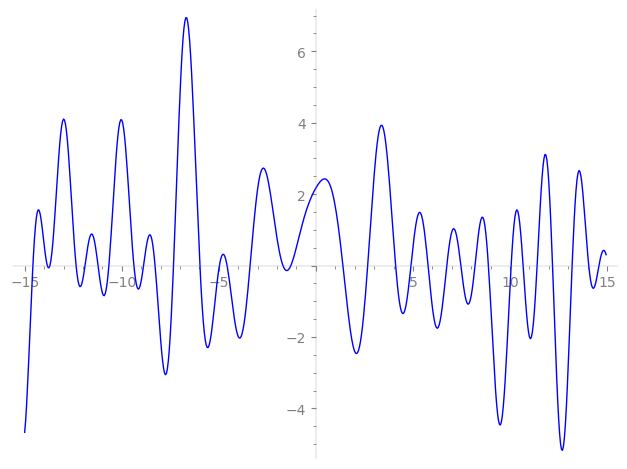| L(s) = 1 | − i·2-s − 4-s + (0.628 − 2.14i)5-s + 5.15·7-s + i·8-s + (−2.14 − 0.628i)10-s + (2.45 − 2.45i)11-s + (0.791 + 3.51i)13-s − 5.15i·14-s + 16-s + (1.15 − 1.15i)17-s + (−0.890 + 0.890i)19-s + (−0.628 + 2.14i)20-s + (−2.45 − 2.45i)22-s + (5.86 + 5.86i)23-s + ⋯ |
| L(s) = 1 | − 0.707i·2-s − 0.5·4-s + (0.281 − 0.959i)5-s + 1.94·7-s + 0.353i·8-s + (−0.678 − 0.198i)10-s + (0.740 − 0.740i)11-s + (0.219 + 0.975i)13-s − 1.37i·14-s + 0.250·16-s + (0.279 − 0.279i)17-s + (−0.204 + 0.204i)19-s + (−0.140 + 0.479i)20-s + (−0.523 − 0.523i)22-s + (1.22 + 1.22i)23-s + ⋯ |
\[\begin{aligned}\Lambda(s)=\mathstrut & 1170 ^{s/2} \, \Gamma_{\C}(s) \, L(s)\cr =\mathstrut & (0.194 + 0.980i)\, \overline{\Lambda}(2-s) \end{aligned}\]
\[\begin{aligned}\Lambda(s)=\mathstrut & 1170 ^{s/2} \, \Gamma_{\C}(s+1/2) \, L(s)\cr =\mathstrut & (0.194 + 0.980i)\, \overline{\Lambda}(1-s) \end{aligned}\]
Particular Values
| \(L(1)\) |
\(\approx\) |
\(2.174311031\) |
| \(L(\frac12)\) |
\(\approx\) |
\(2.174311031\) |
| \(L(\frac{3}{2})\) |
|
not available |
| \(L(1)\) |
|
not available |
\(L(s) = \displaystyle \prod_{p} F_p(p^{-s})^{-1} \)
| $p$ | $F_p(T)$ |
|---|
| bad | 2 | \( 1 + iT \) |
| 3 | \( 1 \) |
| 5 | \( 1 + (-0.628 + 2.14i)T \) |
| 13 | \( 1 + (-0.791 - 3.51i)T \) |
| good | 7 | \( 1 - 5.15T + 7T^{2} \) |
| 11 | \( 1 + (-2.45 + 2.45i)T - 11iT^{2} \) |
| 17 | \( 1 + (-1.15 + 1.15i)T - 17iT^{2} \) |
| 19 | \( 1 + (0.890 - 0.890i)T - 19iT^{2} \) |
| 23 | \( 1 + (-5.86 - 5.86i)T + 23iT^{2} \) |
| 29 | \( 1 - 2.35iT - 29T^{2} \) |
| 31 | \( 1 + (-4.49 - 4.49i)T + 31iT^{2} \) |
| 37 | \( 1 + 6.90T + 37T^{2} \) |
| 41 | \( 1 + (4.06 + 4.06i)T + 41iT^{2} \) |
| 43 | \( 1 + (-4.25 - 4.25i)T + 43iT^{2} \) |
| 47 | \( 1 + 1.21T + 47T^{2} \) |
| 53 | \( 1 + (5.09 - 5.09i)T - 53iT^{2} \) |
| 59 | \( 1 + (7.99 + 7.99i)T + 59iT^{2} \) |
| 61 | \( 1 + 6.91T + 61T^{2} \) |
| 67 | \( 1 + 4.38iT - 67T^{2} \) |
| 71 | \( 1 + (9.29 + 9.29i)T + 71iT^{2} \) |
| 73 | \( 1 + 10.1iT - 73T^{2} \) |
| 79 | \( 1 + 1.67iT - 79T^{2} \) |
| 83 | \( 1 + 8.89T + 83T^{2} \) |
| 89 | \( 1 + (-2.32 - 2.32i)T + 89iT^{2} \) |
| 97 | \( 1 + 17.3iT - 97T^{2} \) |
| show more | |
| show less | |
\(L(s) = \displaystyle\prod_p \ \prod_{j=1}^{2} (1 - \alpha_{j,p}\, p^{-s})^{-1}\)
Imaginary part of the first few zeros on the critical line
−9.373549442083086823451091610434, −8.877081834545190523320180661001, −8.285180108627945383797365590660, −7.33506074987590129429656998797, −5.97373722739108946072125052614, −4.97011402465238990627781558651, −4.57580856905459464601598562349, −3.38963704055077093486762811883, −1.69758567922671210155844192541, −1.29148923491646328128871867915,
1.39122608205329455304138288931, 2.66610089860499550761859359650, 4.10700979888117467239628246135, 4.89774350843969052025662961668, 5.77717282866923329868478678926, 6.74293459856170886392766221912, 7.46735657673214411476651306848, 8.195932346411948800647039047193, 8.884929033309776472982855906992, 10.05702535754967463430622323994

